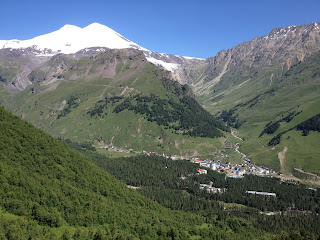On the surface, it looks like a pretty nice walk in the mountains. The route is scenic with nice elevation loss and gain and the views are pretty nice. Adding to the reality of our idyllic little dog walk included details like the fact that we were on an unplowed 4 wheel drive road in January during a snowy stretch with an elevation over 9,000 ft and oh yes, my pack weighed 58#. Thankfully the wind was only 15-20 mph and gusty. It's a funny thing to have some body parts sweating while others are cold at the same time. Aah more practice suffering.
It's on these little jaunts that I think about lots of things basically to take my mind off the hard work, which brings me back to math. If you've read the previous blog titled New Math, you'll remember that I developed a revolutionary mathematical concept for mountaineering effort or work. Now, like all great minds before me, I received feedback on my thesis both positively and negatively. I would like to take this moment and remind my engineering friends that I basically made this stuff up while in a physically induced hallucinatory haze and wrote it down while drinking wine.
Okay now that the air is clear, let's get back to the math. There were two comments that I thought were interesting and worthy of further evaluation. The first was from a friend's father who suggested the PFM formula should account for a person's weight in a more fair manner to somehow normalize the effort. His argument is that a heavier person will appear to have performed less work carrying the same pack weight as a lighter person.
Now there are a few ways to look at this argument. In a pure engineering sense, I agree that a straightforward "work" formula neglecting the person's weight matches textbook theories more closely. If the heavier person is in worse shape than the lighter person, the effort would be the same or even harder because of the additional body weight. But someone like Hulk Hogan who weighs over 300# of pure muscle in his prime, carrying the same 50# pack as me at 175# would have a much easier time of it.
So I think the first thing is to establish a criteria for using the PFM formula which states that for a reasonably athletic and fit person, mountaineering work can be expressed as:
Mountaineering Work = [(Body Wt+Load Wt)/Body Wt] Pounds x Elevation Gained in Feet x Miles walked or Run = PFM
Here's an example from a run I did last weekend:
This is the mountain run near our house. Seems straight forward enough and we've seen it before. But how about this part:
I did it three times last Saturday, first with Mocha, next with Tessa and the last loop by myself. Obviously the plan was flawed because I should have saved the ever loving pulling machine Tessa for the last loop. Stats for this bit of weekend exercise are 7.62 miles, 1,881 ft elevation gain and 1:34 to complete including about 3 minutes for dog swapping. It was hard!Mountaineering Work = 14,418 PFM
This was one of my hardest workouts with second highest PFM rating and it only took 94 minutes!
As is my habit, when the going gets tough, my brain does funny things. During one of the more lucid parts of the run, I was thinking about the other feedback I received from a friend we'll call LW. Now just for a little background, LW is one of my more physically exuberant friends. She's the type of person who travels around the country running marathons for fun, trains for and participates in triathlons during all sorts of weather and basically likes to torture herself as much or more than I do.
LW's comment related to the absence of a time factor in the Mountaineering Work formula. She said that it's obviously harder to the same task faster than it is slower. Of course I initially received this comment as an affront since she can run faster, bike faster swim faster and probably do most everything faster than I can. But after letting it stew for a while and then thinking about it again as I was running mountain loops, I realized what she was really getting at. It's a level of effort thing not just a speed thing. I've been passed by people much older than I am while running races and they seem to be hardly working while I'm breathing hard just trying to maintain pace.
Average Working Heart Rate / Resting Heart Rate
Based on the original Mountaineering Work formula, you would get the same result if the three loops were done at a casual stroll taking 3 hours or more as you do with the 94 minute run. Aha, LW was definitely onto something.
So now, let's rework the numbers with the heart rate factors. My resting heart rate is about 58 and during the run I've estimated from a couple checks that it averaged about 145. The new factor is then 145/58 = 2.5 and the total mountaineering work for the triple loop run is an impressive 36,045 PFM!
Ha, it's just a number but that makes me feel pretty good. Training is going well. Kriss joins me on the weekends and some mornings and I usually have company during weightlifting sessions at Pipestone. Treadmill time is my own and I try not to stare at the View of the World from the Summit of Mt. Everest photo too hard. I'll see that view for myself soon enough....
Training Statistics
Miles Climbing and Running - 299
Elevation Gain - 80,129 ft
Push-ups - 5,021
Sit-ups - 6,250
Weightlifting - 24 hours
Mountaineering Work (No HR Factor) - 344,140



















